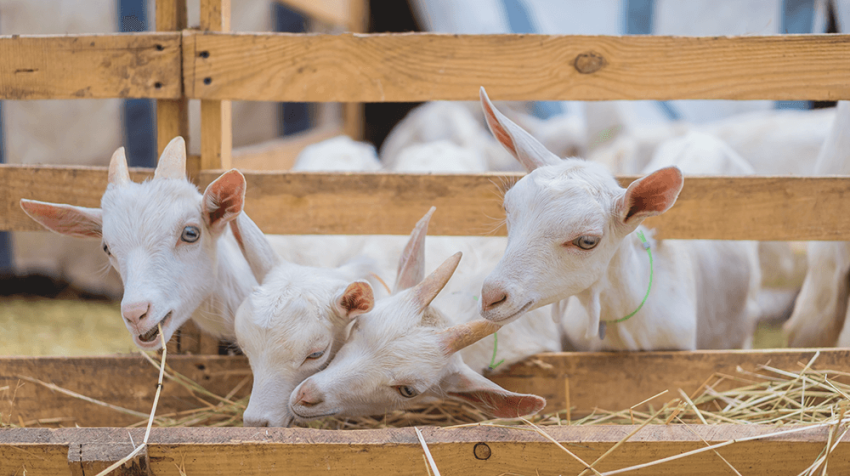There are reasons that the goat farming business is increasingly popular. As hoofed farm critters go, goats are easier to house and feed than other livestock, such as cattle and pigs.
And a goat farmer will tell you that goats are interesting as well as a profitable business. They are social animals with quirky habits.
Here’s how to get started goat farming.
What are Goat Farms?
Goat farms are places where farmers breed and raise domestic goats.
Goats are primarily raised for their milk, meat or fiber. Each goat breed was created distinctly for one of those purposes, although there are some crossover breeds (milk and meat goats).
Any goat breed can be used for a relatively new goat farming purpose – using goats to clear brush. No, they won’t eat tin cans, but they will effectively kill underbrush by eating it.
Miniature goat farming is also popular, as the smaller goats are used as pets and in petting zoos.
How Much Does It Cost to Start a Goat Farm?
You can expect to spend from $100 to $800 for registered breeding stock, with the registered female (doe) bringing top dollar. You may pay about $1,200 for a registered milking goat, such as a Nubian, or for a meat producer doe.
To start, you’ll need a male (buck) and several does. Alternately, you can purchase pregnant goats.
You’ll need a barn or shed and goat proof fencing – typically a combination of “no climb” woven wire and electric fencing. You’ll need a place to provide shelter and store hay, especially if you have a cold, wet winter season.
Minimal milking equipment will cost you at least $1,500. You’ll need state inspection and licensing to produce, process and sell milk, and follow label requirements. This varies by state, but that’s a basic guideline.
You’ll need a truck and a trailer, to pick up hay and to transport goats.
How do Goat Farms Make Money?
- Breed and sell goats.
- Sell milk. Goats must be milked 2x a day and will produce about a gallon.
- Raise and sell goats for meat.
- Rent goats to eat brush, clearing land.
- Raise goats for their fleece, which is sheared (2x a year), washed and eventually spun into high quality yarn.
- Sell dairy products such as soap made with milk.
- Sell fiber goat products such as fleece or yarn.
Starting a Goat Farm in 19 Simple Steps
As with many farming ventures, start with research. Research breeds, nd also learn your local zoning ordinances before you bring them to your new farm.
1. Decide What Type of Goat Farm to Run
Meat
Milking
Fiber
Miniature
Rental
2. Select Your Goat Breed (Dairy Goats or Meat Goats)
Dairy and meat are the two main choices, and there are different breeds within those two types. A meat goat is typically larger than other breeds. The dairy types must be milked two times a day to produce milk.
The male goat is made a “wether” (castrated) at about 10 to 12 weeks old.
Let’s talk Goat Production 101. Does to into heat every 21 days. When the does are in heat, an intact buck will urinate on itself. Goat farmers know that the timing of mating is critical, so males are kept separate from the females. But due to their habits, the intact males have a strong, offensive odor.
You only need one buck, at first. If they won’t be used for breeding, other males are made “wethers” (castrated) at about 10 to 12 weeks old. They won’t smell like the intact male bucks do.
One of the most popular of the miniature goat breeds is the Nigerian dwarf. They get along well with other animals and they’re, well, adorable.
3. Do a Market Survey
Are there other goat farms in your area? What are they raising? Any type of goat farming is a niche; make sure your new business will be able to compete.
Go to your state’s Farm Show, talk to a goat farmer or two. Subscribe to farm journals and other resources.
4. Make Sure You Have the Necessary Qualifications Knowledge on Raising Goats
Although they are hardy animals, they can get sick. You’ll need to train yourself to notice any changes in behavior that may require medication or a visit from a veterinarian.
You’ll need planning skills, to set up long-term feed suppliers.
You’ll need general contractor skills, to maintain the electric fencing, build and repair the animals’ housing, build and repair hay mangers and other general farm work.
You’ll need to be someone who doesn’t mind hard, outdoor work.
5. Create a Goat Farming Business Plan
A commonality of goat farming is an expectation that you may have losses as you build stock. Let’s say you start with one buck and three does. The does have goat kids; now you have 7. But you can’t use your original buck to breed to the young females since he is too closely related. He can be used to rebreed those 3 original does, but you need another buck (or a loaner) to breed the youngsters.
Items in your goat farming business plan:
- Set up housing and fencing for the animals.
- Set up reliable food sources for hay and grain. Build a place to store hay and grain out of the weather.
- Buy good quality new goats to start your goat farming business.
- Make a breeding schedule. As we stated, females go into heat every 21 days. The gestation period is 145 to 155 days. Depending on your climate, you want to time births in general for spring months. Neutered males can live with the females.
- Develop a marketing plan for where you will sell and how you will grow the herd.
- Set aside money for veterinary costs, which is a part of owning livestock. As with any farm animal, they are susceptible to diseases.
6. Name and Brand Your Business
Choose a name that reflects the type of business you’re going to operate.
For example, Bleating Brush Clearers conveys a different focus than Mikey’s Mini Kids.
7. Form a Legal Entity and Register Your Goat Business
The Limited Liability Company, or LLC, is highly recommended.
An LLC makes sense because as a herd in a fence, the species is notorious for escape. They are extremely athletic. Nearly everything is food to them, including your neighbors’ expensive landscape plants or farm crops.
A business is typically registered with the Secretary of State.
Other choices are a sole proprietorship, partnership or corporation.
8. Buy the Necessary Equipment
In addition to the housing and fencing, and hay storage area, you’ll need:
Mangers and hay racks, grain troughs (best design is accessible from outside the building, so the herd doesn’t crowd you, making feeding easier). Food should be kept dry. Two times a day feeding is best.
Wheelbarrows, rakes and shovels, hoses
Truck and trailer
Separate area for pregnant (nearly due) females, lactating females and kids, along with feeding areas for them.
Hoof trimmers
9. Open a Business Bank Account
Definitely have a separate business bank account and a separate business credit card.
10. Choose a Location and Consider Zoning
Most likely you will need zoning that is Agricultural. And there are guidelines for that.
Learn your zoning laws. Zoning can differ by state. Most commonly, hoofed farm stock is counted by “animal unit.” Larger animals, such as horses and cattle, count as one unit each. For smaller animals, such as goats, sheep and swine, it takes four of them to equal one unit.
Commonly, 1 unit is allowed per half acre.
In other words, if you fence off one acre you could keep 8 goats within it.
11. Purchase and Sort Out Licenses
You’ll need farm insurance, which falls under general agribusiness insurance. Each state has a farm bureau, which is a great source of information on this topic.
For instance, you can opt for “blanket” coverage for buildings, equipment and stock.
You’ll need a business license. If you’re going to sell products you’ll need an EIN, or Employer Identification Number, which you’ll use to pay sales tax or taxes you’ll pay if you hire employees.
12. Build a Pasture and Goat House
Your stock needs a shelter where they can stay dry and out of the wind. You’ll need to keep the bucks and does, so the bucks don’t breed the does at the wrong time of year.
Although it may be more cost effective to adapt an existing structure, there are features that make your life easier. Those features include a no-freeze water hydrant, and easily accessible hay mangers and feed troughs. Not having to hand-carry water is an important factor.
You’ll have to check the pasture fencing as a routine, because fallen branches or branch growth can touch the electric wire. If that happens, your electric fence won’t work properly.
Add high quality food to the daily pasture browse. Neighbors who are clearing brush may want to “donate” those branches to you but remember that certain feeds (such as walnut tree leaves and twigs) are poisonous to goats.
13. Hire Employees
Your hardest challenge will be hiring someone who can take care of your farm when you’re away. As part of marketing, you may be attending farm shows and similar events. You’ll need a reliable person who can feed and water, and also notice if any of the stock seem ill.
14. Purchasing Goats
If possible, buy your stock shortly after they had a health check, also called a health clearance, from a veterinarian. A health clearance from a veterinarian should state the goat, on a certain date, was free from communicable diseases. If you’ll be crossing state lines, you’ll need a health clearance.
When adding new ones to an existing herd, keep the new ones separate for a period of time.
15. Care for and Raise Goats
Stick to a feeding schedule as best you can. Two times a day is recommended. For optimum nutrition, they need constant access to clean water and plenty of fresh air.
When the stock reaches breeding age, begin your goat rearing venture.
16. Market the Business
Attend farm shows and consider setting up a booth there and at other agriculture-themed events.
If you’re selling products, develop a brochure and business cards you can leave at promising business outlets.
Create a FB page and website.
Depending on which breed you’ve chosen, visit butcher shops, specialty grocers, farm markets and health food stores.
17. Create Your Products
Goat meat and milk are common products. The actual animal itself – sold to become part of a petting zoo or brush clearing herd – is a product in itself. If you’ve opted for fiber, you can sell finished yarn or the sheared and washed fleeces.
You need a state license to produce, process and sell milk. Your equipment and processing area must meet strict sanitary guidelines. You’ll be inspected to get a license for that business, which is most often called a Dairy Processing Plant License. There will also be product labeling requirements.
Often a meat goat is shipped live to a butcher shop. Each goat needs to have a tag affixed to it that gives the location of its home herd, plus have an identifying ear tag, chip or tattoo.
18. Choose Where to Sell Your Products
Farm Stand
Specialty Groceries
Health Food Store
Agriculture themed events and fairs
From your farm
19. Expand Your Business
Compared to other livestock, goats are easier to transport. Do visits to schools, or if you’re selling products at a fair, bring a hoofed friend or two along to drive traffic to your booth.
If your farm is attractive, consider inviting the public to learn more about what you do.
What is the average goat farming profit?
Most who are getting started count on outside income as they build the herd and this should be part of your small farm business plan.
Those who supply “grazer” brush clearing goats are currently getting about $800 a week for the service.
As an industry, on average, the annual salary ranges from $34,000 to $49,000.
Image: Depositphotos









Webster hamainza
This is quite interesting. I also registered for goats rearing project. Am registered under Pacra and successfully made it. I have a challenge on how to find donors to start up my project.